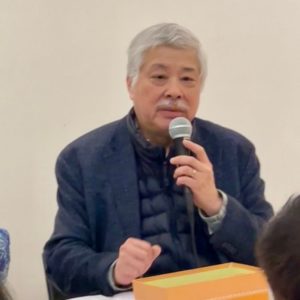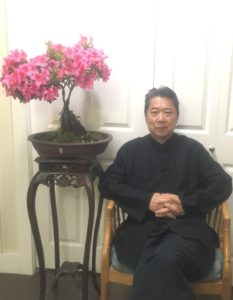National Stone and Chinese Arts Asian Heritage Week Exhibit Item (A)
Stone, Seal Carving and Bonsai
About Seals

Ruibin Liang
The use of seals in China has a history of over two thousand years. The oldest known seals in history can be traced back to the Three Bronze Seals of Shang Dynasty from the Yan Ruins in Anyang, Henan. Seals were mainly used as credit certificates or family emblems. Their popularity reached its peak during the Shang Dynasty and the Zhou, Qin and Han Dynasties; with various vibrant and creative styles of seals designs emerged, which were highly respected by later seal engravers. As the ancient script was mainly based on seal script calligraphy, ancient seals also laid the foundation for the art of seal carving.
Materials used for seals in different dynasties included jade, metal, ivory, bamboo, wood, and animal bones. During the Yuan Dynasty, Wang Mian began using HuaRui Stones, having lower degree of hardness, to make seals. Since then, the selection of seal materials has been primarily based on beautiful stones. The skill of seal carving was no longer exclusive to craftsmen but also became a skill for scholars. “National Stones” such as Qingtian Stones,Shoushan Stones, Changhua Stones and Balin Stones also became popular materials for seals among scholars during the late Qing Dynasty and the Republic of China. The carving of seals gradually became a fashion and collectible for scholars. The warm and smooth texture of seal stone, as well as its easy-to-carve characteristics, provided excellent materials for seal carving. Although seal carving is less common in contemporary times, many seal lovers in Vancouver still use these precious stones for seal carving, and this wonderful national heritage able to be preserved.
Article in Chinese by Ruibin Liang
The Fine Chinese Stones

John Chan
President of IAG Antiques & Collectables Club
Fine stones refer to precious stones that are suitable for carving into collectible handicrafts. In addition to being naturally occurring materials, fine stones are further processed by skilled craftsmen to make them more lifelike, vivid in shape, rich in meaning, and widely sought after by collectors.
China has rich collection of nearly a thousand types of stones, but the four main series of national stones that are highly valued include Shoushan Stones, Qingtian Stones, Changhua Stones and Balin Stones. Among them, Shoushan Stones is the most popular and has over a hundred varieties, but none are more precious than Shoushan Tianhuan Stones. Due to its rarity and historical significance in collection, it is known as the “King of Stones.” The other national stones also have their own unique characteristics and beauty, with a variety of carving techniques including round carving, relief carving, and thin carving.
Fine stone collections mainly include seals, large carvings, small ornaments, and portable accessories. During this Vancouver Asian Heritage Month ExplorASIAN 2023, we will showcase different types of fine Chinese stones for everyone to appreciate at our “National Stone and Chinese Arts Asian Heritage Week” event.
Article in Chinese by John Chan
President of IAG Antiques & Collectables Club
The Chinese Ornamental Stones

Wang Ka Wen
Ancient Stone Studio
The culture of Chinese ornamental stones has a long history. During the Warring States Period, Meng Changjin collected more than ten carts of Floating Chime(according to research, they were Lingbi Stones), Chinese ornamental stones mainly consist of Shaped Stones and Textured Stones. The former is primarily evaluated based on its shape, while the latter is evaluated based on its texture. Among them, Taihu Stones and Lingbi Stones are the most famous shaped stones, and the Yuhua Stones are widely known for their texture. For thousands of years, ornamental stones have been a symbol of taste and status for scholars, officials, and the wealthy in Chinese culture.
Since the end of the Cultural Revolution in China (Chinese sociocultural movement), there has been a gradual revival of stone culture, including activities such as playing with Bonsai, Offering Stones(Ornamental Stones), Calligraphy, and the establishment of various traditional cultural organizations and stone appreciation groups. In the early 1990s, a stone association and a stone appreciation group were established in Vancouver, Canada. With the growth of overseas Chinese communities, the Greater Vancouver Stone Association was established. Meanwhile, mainstream Western European stone associations had already properly established..
Local promotion of ornamental stones has been stagnant due to a shortage of resources and lack of supply, as it depends on imports from Mainland China and the scarcity of Chinese people interested in it. Additionally, it was temporarily suspended during the difficult period of the Pandemic.
However, local collectors groups have been maintaining communication with various stone associations in Mainland China, Taiwan, Malaysia, South Korea, etc., through WeChat communications, photos and articles. The collectors group have also incorporated the requests of Western collectors groups to include fossils to their category of studies, to emphasize more on scientific knowledge in stone appreciation in respect of quality, colour, pattern, and mineral rocks, as a communication between China and the West. These exchanges with western collectors have been welcomed by the Chinese stone lovers, and China has invited the Canadian stone association to visit and exchange ideas on several occasions. In recent years, stones exhibitions have reached their peak in different cities and towns throughout Mainland China, which is truly a joyful thing.
Article in Chinese by Wang Ka Wen of Ancient Stone Studio
The Bonsai

Peter Meng
Groud Drawing Studio
Bonsai, one of China’s excellent traditional arts, is an art form using plants and rocks as the basic materials to create miniature natural landscapes within a container. It uses materials such as plants, rocks, soil, and water, and through artistic creation and horticultural cultivation, it typifies and concentrates the beautiful scenery of nature within the container, and achieves the artistic effect of “shrinking the world into inches” and making the small appear large. At the same time, it expresses profound sentiments through scenery, like a three-dimensional, beautiful miniature version of the natural landscape.
Bonsai is a condensed form of natural scenery. Its emergence and development have a certain relationship with landscape painting and landscape gardening. Bonsai appeared as early as the Tang Dynasty. In 1971, a mural was discovered in the tomb of Prince Tang Zhanghuai depicting a lady holding a bonsai. In the painting of “Tribute” by Yan Liben of Tang Dynasty, there is a depiction of offering rocks and stones, bonsai includes tree and rock, There are many styles with varying characteristics.
Today, bonsai enthusiasts are spread all over the world, and many bonsai works by famous artists from past decades have entered the auction market and become “living antiques” by collectors. There are also has many bonsai associations and enthusiasts in Vancouver of Canada. During the “Asian Heritage Month,” some bonsai works will be displayed to showcase the art of Chinese bonsai and to achieve the goal of promotion and cultural exchange.
Bonsai is a “three-dimensional painting,” a “silent poem,” and a “living antique”.
Article in Chinese by Peter Meng of Groud Drawing Studio
